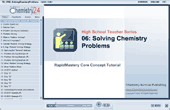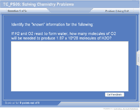Problem Solving in Chemistry
| Topic Review on "Title": |
Problem-solving can be a very difficult task. But when a specific “attack” is used, the problems can be solved much more easily.
General Problem-Solving Technique
A technique for solving any type of problem involves:
- Identify what’s being given
- Clarify what’s being asked
- Select a strategy (trial and error, search, recall, deductive reasoning, working backwards, etc)
- Solve using the selected strategy
- Review your answer
Problem-Solving Technique for Word Problems
A problem-solving strategy that turns the above “general” strategy into a strategy specifically for solving word problems is the KUDOS method:
- K = Known (identify the known)
- U = Unknown (identify the unknown)
- D = Definition (identify definitions, equations, equalities, constants needed)
- O = Output (use your definitions to output an answer)
- S = Substantiation (check appropriateness, units and significant figures of your answer).
Preparing for a Test
There are several tips to help you prepare for a test:
- Stay ahead of the game. Don’t wait until the last minute. If you wait until the last minute to prepare, there won’t be time to seek out help if you encounter problems.
- Make a cheat sheet. Even if you can’t use it on the exam, making a concise “cheat sheet” helps you focus in on key information and is a great study technique.
- Know the format of the exam and what information is “test-able” (what you’ll be responsible for). Ask your instructor well in advance for this information.
- Make a mock-exam. Select the key information and make a practice exam for yourself.
- Attend any review sessions offered, even if they are optional. Often, key information is given in these sessions that is not said in the general class period.
- Get help early. If you have any problems, seek out your instructor ahead of time. Instructors do not like last minute cramming questions.
Taking a Test
Several tips can help improve your test scores:
- Arrive early and be prepared. Rushing can increase anxiety and decrease performance
- Listen and read instructions carefully. Your instructor may give changes to the questions or instructions. Don’t assume you know what a problem is asking…always read the instructions!
- Memory dump. On the back or top of the test, write all information you’ve been “storing” in memory. This allows a “bank” for you to refer to as you work through the test and prevents anxiety about forgetting information.
- Skim the test and make a plan. Budget your time accordingly.
- Answer questions sequentially. Often information from previous problems is used later in the test—try not to skip around.
- Apply the guessing rule. Don’t randomly guess, but if you can eliminate a few of the selections, guess among the remaining.
|
| Rapid Study Kit for "Title": |
| Flash Movie |
Flash Game |
Flash Card |
| Core Concept Tutorial |
Problem Solving Drill |
Review Cheat Sheet |
 |
 |
 |
|
| "Title" Tutorial Summary : |
You will encounter problems throughout your chemistry course. A “problem” is anytime you don’t know how to get from the known information to the unknown information. Having a systematic method to “attack” problems can make them much easier. A general problem-solving technique is introduced in this tutorial as well as a specific technique for word problems. Tips for preparing for and taking tests are also given.
|
| Tutorial Features: |
Specific Tutorial Features:
- The problem-solving technique is applied to chemistry applications
Series Features:
- Concept map showing inter-connections of new concepts in this tutorial and those previously introduced.
- Definition slides introduce terms as they are needed.
- Visual representation of concepts
- Animated examples—worked out step by step
- A concise summary is given at the conclusion of the tutorial.
|
| "Title" Topic List: |
- General Problem solving technique
- Problem solving technique for word problems
- Preparing for tests
- Taking test
|
See all 24 lessons in college chemistry, including concept tutorials, problem drills and cheat sheets:
Learn Yourself to Teach Chemistry Visually in 24 Hours |